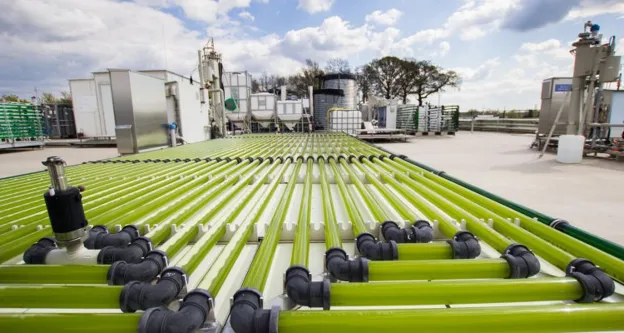Greenhouses, like many other industries, need to reduce their freshwater demand and CO2 footprint. By growing microalgae in the drain water of greenhouses, the overall fresh water usage can be reduced, and the water will become cleaner. Furthermore, the microalgae will be used for valuable products like biostimulants to boost crop yield production under normal or stressful conditions.
That's the reason why European microalgae researchers, agricultural producers, and technology experts connected the dots and initiated the new research project REALM (Reusing Effluents from Agriculture to unlock the potential of Microalgae).
WUR researchers Maria Barbosa and Rumyana Karlova – one working for the Agrotechnology & Food Sciences Group (AFSG), the other for the Plant Science Group (PSG) - are closely involved in the project. "We think the urge for the use of micro-algae is there. There is definitely a demand at this moment."

Clean water
Run-off from greenhouses or improperly treated drain water can cause environmental problems. Nitrogen, phosphorus, and other nutrients added to the irrigation water for fast and healthy plant growth can be washed into rivers and lakes, which causes wild plants and algae to grow excessively and quickly deteriorate the water quality. The result is that dead zones arise in which only a little oxygen is freely available to fish and other aquatic creatures – too little for them to survive. Besides that, it also takes a lot of energy to make fertilizers, which are just drained down to the rivers and ultimately to the ocean.
"Microalgae can be the answer to these problems," Maria says. "These small plants are photosynthetic micro-organisms which can grow in seawater or fresh water, in contained and controlled vessels called photobioreactors. Microalgae take nitrogen and phosphorous from residual streams. This frees up fresh water for other purposes like crop irrigation or the production of drinking water."
100% efficiency
Rumyana adds: "Our goal is to get to 100 percent efficiency in taking nitrogen from residual water. It could reduce carbon emissions because the nitrogen won't go back to the water stream. That is a win-win: zero waste and a clean product."
One of the bottlenecks for commercial production of microalgae for medium and low-value products is the high production costs. The purpose of the REALM project is to join greenhouse farmers with microalgae producers in the most economical way. In the best case, it can cut the production costs of microalgae in half. Reduced production costs can help microalgae producers reach more sectors and lower-price markets.
The new project is also a possibility for new microalgal-based products as biostimulants in agriculture to reduce the use of chemical fertilizers and as feed in aquaculture, generating extra income, in essence, transforming waste into value for a cleaner environment.
"It sounds simple, but you have to combine two industries," the researchers say. "This asks for a totally new way of working. If you are dependent on these streams, one must address changes in the nutrient composition in the drain water throughout the seasons and adapt the microalgae cultivation process accordingly for a 100% nutrient uptake at maximal biomass productivity. We must bring it into practice and make a proof of concept that works."
Put research into practice
One of the main goals of the REALM project is to put into practice the micro-algae research for nutrient recovery and circularity in greenhouses. "The biggest companies for microalgae are involved. It's unique that so many companies would like to invest in this technology to eventually implement it. This is a growing industry, and we will grow a lot in the next years."
Last month, the interdisciplinary team started working to make the REALM concept a reality. Within the next four years, they want to establish automatic, low-cost production systems that grow microalgae next to greenhouses.
Source: wur.nl
